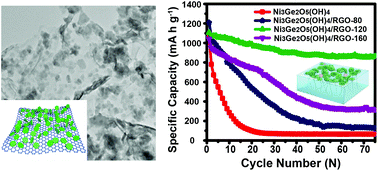Enhanced lithium storage performances of novel layered nickel germanate anodes inspired by the spatial arrangement of lotus leaves†
Abstract
The rapid capacity degradation of Ge-based materials hinders their practical application for next generation lithium ion batteries, which could be solved by synthesizing Ge-containing ternary oxides, with new structures and hybridizing with carbon nanomaterials. Herein, novel Ni3Ge2O5(OH)4 nanosheets were synthesized and distributed in situ on reduced graphene oxide (RGO) sheets, with both flat-lying and vertically-grown spatial distributions to imitate the growth of lotus leaves. These two types of Ni3Ge2O5(OH)4 nanosheets enhance their efficient contact with RGO, and increase the mass loading of active materials. Furthermore, the interfacial bonds between RGO sheets and Ni3Ge2O5(OH)4 nanosheets are introduced to improve the diffusion rate of lithium ions. The RGO sheets act as a buffer matrix to sustain the volume change and prevent the nanosheets from aggregation. Consequently, the chemically bonded Ni3Ge2O5(OH)4/RGO hybrid delivers a high specific capacity of 863 mA h g−1 over 75 cycles, which is much higher than those for neat Ni3Ge2O5(OH)4 nanosheets or the hybrid without the interfacial bonding. This study provides a novel perspective for designing high-performance Ge-based anode materials for advanced lithium ion batteries.



 Please wait while we load your content...
Please wait while we load your content...